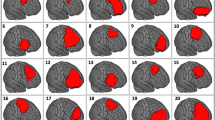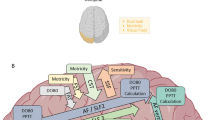Abstract
Objective
The objective of the present study was to retrospectively evaluate the relationship between tumor grading and a selective evaluation of neurocognitive and behavioral functions in children with supratentorial hemispheric brain tumors.
Methods
Children admitted with a diagnosis of supratentorial hemispheric tumors involving the cerebral hemispheres or the thalamus at the Pediatric Neurosurgery Unit of the Catholic University of Rome between January 2008 and January 2014 were considered for the present study. Exclusion criteria were represented by age less than 2 years, severe neurological deficits, seizures, and a metastatic disease. A selective neurocognitive and behavioral workout was used for children aged less and more than 5 years.
Results
Global cognitive functions as well as selective neurocognitive and behavioral profiles were found to be significantly worse in children with low-grade tumors, compared with those affected by higher-grades histotypes. Frontal locations for cortical tumors and thalamic lesions were significantly related with worse results, with a clear contribution of dominant vs. nondominant hemisphere involvement and an age higher than 5 years.
Conclusions
Preoperative global and selective neurocognitive evaluation might contribute to the prediction of the tumor aggressiveness. Due to a longer clinical history, more benign tumors more frequently arrive to the diagnosis with a neurocognitive compromise in spite of an apparently mild presence of neurological symptoms and signs.
Similar content being viewed by others
Abbreviations
- CBCL:
-
Child behavior checklist
- DTI:
-
Diffusion tensor imaging
- FSIQ:
-
Full scale IQ
- GMDS-R:
-
Griffiths mental developmental scale–revised
- Leiter-R:
-
Leiter international performance scale–revised
- NSS:
-
Neurological severity score
- PIQ:
-
Performance IQ
- TIQ:
-
Total IQ
- VIQ:
-
Verbal IQ
References
Iuvone L, Peruzzi L, Colosimo C, Tamburrini G, Caldarelli M, Di Rocco C, Battaglia D, Guzzetta F, Misciagna S, Di Giannatale A, Ruggiero A, Riccardi R (2011) Pretreatment neuropsychological deficits in children with brain tumors. Neuro-Oncology 13:517–524
Van’t Hooft I, Lindahl Norberg A, Bjorklund A, Lonnerblad M, Stromberg B (2016) Multiprofessional follow-up programmes are needed to address psychosocial, neurocognitive and educational issues in children with brain tumours. Acta Paediatr 105:676–683
Bonfield CM, Steinbok P (2015) Pediatric cerebellar astrocytoma: a review. Childs Nerv Syst 31:1677–1685
Di Rocco C, Chieffo D, Pettorini BL, Massimi L, Caldarelli M, Tamburrini G (2010) Preoperative and postoperative neurological, neuropsychological and behavioral impairment in children with posterior cranial fossa astrocytomas and medulloblastomas: the role of the tumor and the impact of the surgical treatment. Childs Nerv Syst 26:1173–1188
Di Rocco C, Chieffo D, Frassanito P, Caldarelli M, Massimi L, Tamburrini G (2011) Heralding cerebellar mutism: evidence for pre-surgical language impairment as primary risk factor in posterior fossa surgery. Cerebellum 10:551–562
Chieffo D, Tamburrini G, Caldarelli M, Di Rocco C (2014) Preoperative neuropsychological and behavioral evaluation of children with thalamic tumors. J Neurosurg Pediatr 13:507–513
Dennis M (2010) Language disorders in children with central nervous system injury. J Clin Exp Neuropsychol 32:417–432
Wessling C, Bartels S, Sassen R, Schoene-Bake JC, von Lehe M (2015) Brain tumors in children with refractory seizures—a long-term follow-up study after epilepsy surgery. Childs Nerv Syst 31:1471–1477
Griffiths R (1984) The abilities of young children. A comprehensive system of mental measure for the first eight years of life. Test Agency, High Wycombe
Griffiths R (1996) The Griffiths mental development scales: from birth to 2 Years. Test Agency, High Wycombe
Leiter RG (2002) Leiter international performance scale revised (LIPS-R). Western Psychological Service, Los Angeles
Achenbach TM, Edelbrock C (1983) Manual for the child behavior checklist and revised child behavior profile. University of Vermont, Burlington
Achenbach TM, Rescorla L (2000) Manual for the ASEBA preschool forms and profiles. University of Vermont, Burlington
Orsini A, Picone L (2006) WPPSI-R: Contributo alla Taratura Italiana. Giunti Organizzazioni Speciali, Florence
Beery KE, Buktenica NA (2000) VMI developmental test of visual-motor integration. Organizzazioni Speciali, Florence
Kosla K, Bryszewski B, Jaskolski D, Blasiak-Kolacinska N, Stefanczyk L, Majos A (2015) Reorganization of language areas in patient with a frontal lobe low grade glioma - fMRI case study. Pol J Radiol 80:290–295
Ivanov I, Bansal R, Hao X, Zhu H, Kellendonk C, Miller L, Sanchez-Pena J, Miller AM, Chakravarty MM, Klahr K, Durkin K, Greenhill LL, Peterson BS (2010) Morphological abnormalities of the thalamus in youths with attention deficit hyperactivity disorder. Am J Psychiatry 167:397–408
Schmahmann JD (2003) Vascular syndromes of the thalamus. Stroke 34:2264–2278
Author information
Authors and Affiliations
Corresponding author
Ethics declarations
Disclosure
The authors report no conflict of interest concerning the materials or methods used in this study or the findings specified in this paper.
Rights and permissions
About this article
Cite this article
Chieffo, D., Tamburrini, G., Frassanito, P. et al. Preoperative neurocognitive evaluation as a predictor of brain tumor grading in pediatric patients with supratentorial hemispheric tumors. Childs Nerv Syst 32, 1931–1937 (2016). https://doi.org/10.1007/s00381-016-3170-7
Received:
Accepted:
Published:
Issue Date:
DOI: https://doi.org/10.1007/s00381-016-3170-7




